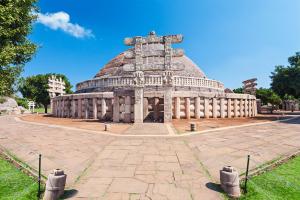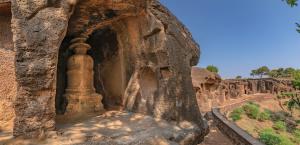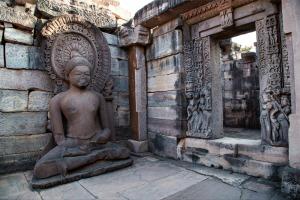
Discover the Ancient Buddhist Pathways and Architectural Marvels in the Heart of India
BHOPAL, MADHYA PRADESH, INDIA, May 22, 2024 /EINPresswire.com/ — Madhya Pradesh, an offbeat multispecialty destination of first choice is often recognized as the heart of India, is a land steeped in history and cultural richness, offering a captivating journey for those seeking to explore the ancient path of Buddhism. Beyond its breathtaking landscapes and majestic forts, the state avowals a rich Buddhist heritage, waiting to be discovered by pilgrims and travelers alike.
The history of Buddhism in Madhya Pradesh dates back to the 3rd century BCE, when Emperor Ashoka, the grandson of Chandragupta Maurya, embraced Buddhism after the Kalinga War. Ashoka’s dedication to Buddhism established Madhya Pradesh as a major center for the religion. The state is home to numerous stupas, monasteries, and archaeological sites, such as Sanchi, where Sanchi Stupa No. 1 stands as one of India’s oldest stone structures. These monuments feature intricate carvings that depict the life of Buddha and stories from the Jataka tales, offering insight into the artistic heritage of Buddhist art and architecture.
Emperor Ashoka’s creation of 84,000 stupas and the redistribution of Buddha’s ashes are monumental. At Sanchi, a circumambulatory path known as a Vedika surrounds the stupa, emphasizing the importance of Parikrama (circumambulation) in Buddhist rituals. The addition of a Harmika (a square structure) and a three-tier Chhatri or Chhatravali atop the stupa symbolizes the three jewels of Buddhism: Buddha, Dharma (teachings), and Sangha (community).
Madhya Pradesh offers a plethora of Buddhist sites, each with its own unique story to tell. Some of the most prominent include:
Sanchi Stupa: A UNESCO World Heritage Site since 1989, it is one of the oldest and best-preserved Buddhist monuments in India, dating back to the 3rd century BCE. It features intricate carvings and sculptures depicting the life of Buddha.
Sanchi Archaeological Site: This site includes several monasteries, temples, and stupas, providing a glimpse into the vibrant monastic life that once flourished here.
Satdhara: This site features stupas, a chaitya, and a rock shelter with Buddha figures from the Maurya and Gupta periods. Relic caskets found here are believed to contain the remains of Sariputra and Mahamauglayan, celebrated disciples of Buddha.
Saru Maru: Known for its stupas and natural caves, this site has inscriptions and drawings inside the caves. It is said that Emperor Ashoka visited and lived here briefly.
Sonari: This archaeological site houses a stupa believed to have contained Buddha’s relics, with one ornate reliquary now displayed at the Victoria and Albert Museum in London.
Andher and Murelkhurd: These tranquil sites feature clusters of stupas and monasteries, ideal for meditation and reflection.
Deorkothar: Located in Rewa district, this site contains over 40 stupa remnants. An inscribed pillar here references Acharya Dharmadeo and his students, highlighting their presence at the site.
Reaching Sanchi is convenient, with the nearest airport at Bhopal, just 46 kilometers away. Sanchi Railway Station is the nearest rail station, 1.5 kilometers from the historical site, connecting it to major cities. Buses and taxis offer easy access from nearby towns. A notable highlight is that the IRCTC started “the Buddhist Circuit Tourist Train” which offers an incredible and comfortable journey to all the important Buddhist sites across India & Nepal.
Neighboring the Sanchi Stupa are the Udaygiri Caves, another captivating attraction. These rock-cut caves, adorned with sculptures and inscriptions, offer a glimpse into the lives of early Buddhist monks. History buffs can stand astride the Tropic of Cancer that passes through Sanchi, marking a significant geographical landmark. Visitors can also explore the Heliodorus Pillar, a mere 11 kilometers from Sanchi.
Sanchi’s appeal extends beyond its immediate vicinity. It forms part of the renowned Buddhist Circuit in India, which encompasses other historically significant sites like Gaya, the place of Buddha’s enlightenment, and Sarnath, where he delivered his first sermon. Exploring this circuit allows visitors to trace the footsteps of the Buddha and gain a deeper understanding of Buddhism’s origins and spread.
For those seeking academic immersion, Sanchi University offers unique Indo-Buddhist courses, delving into the history, philosophy, and artistic expressions of Buddhism. In a recent heartwarming event, the sacred relics enshrined within the Sanchi Stupa embarked on a special journey to Thailand. This exchange showcased the deep cultural and spiritual bonds between India and Southeast Asia. The relics were received with immense enthusiasm in Thailand, drawing thousands of devotees who sought blessings and a deeper connection to the Buddha’s teachings.
A highlight for devout Buddhists and curious visitors alike is the annual relic festival held in Sanchi. During this special occasion, the sacred relics enshrined within the Sanchi Stupa are displayed for public viewing, offering a rare opportunity for spiritual connection.
Madhya Pradesh stands true to its title as a premier destination for discovering India’s rich Buddhist heritage, offering an enriching experience that spans history, spirituality, and cultural immersion.
Sanjay V Shetye
Vinsan Graphics
+91 98238 77416
email us here
Sanchi Stupa Holy Centre of Buddhism | Sanchi | Raisen | Bhopal | Madhya Pradesh Tourism
![]()
Originally published at https://www.einpresswire.com/article/713611281/madhya-pradesh-a-beacon-of-buddhist-heritage





